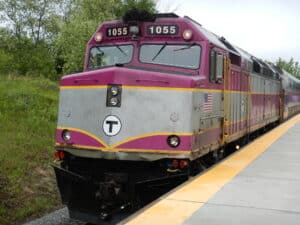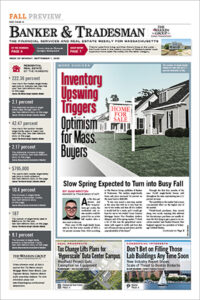
An MBTA commuter rail train waits at a station in 2019. Photo by Paul Morris | Flickr / CC BY-SA 2.0
Acting quickly on a bill Gov. Charlie Baker signed last month, state officials this week released preliminary guidance applicable in dozens of municipalities that face a new, transit-oriented multifamily housing zoning requirement.
The economic development bond bill signed by Baker changes the state’s zoning enabling law and requires MBTA communities to have “at least one zoning district of reasonable size in which multi-family housing is permitted as of right,” according to the state Division of Local Services.
The districts must also meet other multi-family housing criteria, including a minimum gross density of 15 units per acre; not more than half a mile from a commuter rail station, subway station, ferry terminal or bus station; no age restrictions; and suitable for families with children. Because many communities served by the MBTA’s subway lines already have multifamily zoning, the biggest impact will likely be felt along its commuter rail network.
The guidelines governing compliance with the new law will ultimately be issued by the state Department of Housing and Community Development, an agency that is overseen by state Secretary of Housing and Economic Development Michael Kennealy. Communities that fail to comply with the new law will lose access to state grants like the MassWorks infrastructure program, although they remain eligible for grants at least until more specific guidance is made available.
The guidelines leave important details to be addressed at a later date, like the size of zoning districts and how the state will grade towns’ compliance with the new law.
The document released Wednesday states that the state will seek input from municipalities and the MBTA soon, and that it “anticipates that its compliance guidelines will account for the fact that different communities have different needs and that communities considering the adoption of new zoning will, in many cases, require time for a planning process and community input.”






